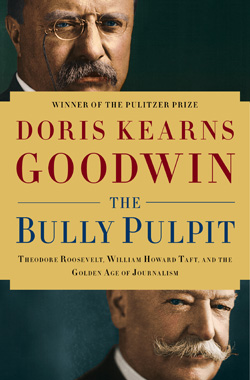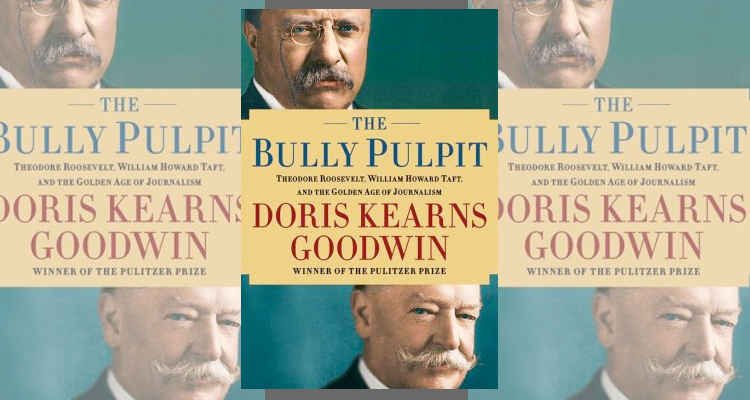 THE BULLY PULPIT: Theodore Roosevelt, William Howard Taft, and the Golden Age of Journalism, by Doris Kearns Goodwin (Simon & Schuster)
THE BULLY PULPIT: Theodore Roosevelt, William Howard Taft, and the Golden Age of Journalism, by Doris Kearns Goodwin (Simon & Schuster)
Here’s some of what’s in Doris Kearns Goodwin’s latest tome: progressive Republicans who insist that the working poor have rights, too; magazines that regularly publish long-form investigative journalism not only because it’s the right thing to do, but because people demand to read it; reporters whose opinions and input are actively sought and, once in a while, acted upon by a sitting president.
At which point, you wonder if the woman who arguably holds the unofficial title of America’s Historian has veered into epic fantasy.
But the era Goodwin chronicles to sweeping, near-exhaustive effect really did happen a century ago, though even with all the book’s facts in order, they’re still hard to imagine—which says more about how government and journalism work (or don’t) now than how they did back then.
The Bully Pulpit is three epochal stories in one. The meteoric rise of Theodore Roosevelt from legislative backbencher to big-city police commissioner to Rough Rider to U.S. president receives yet another run-through here. It is interwoven with the less pyrotechnic but spectacular-in-its-own-way ascension of William Howard Taft, from Ohio magistrate to governor-general of the Philippines to Roosevelt’s secretary of war and hand-picked successor, whose warm friendship with his predecessor was transformed by ideological differences into frosty antagonism.
Goodwin’s third narrative, her most fascinating if less prominent, concerns the cadre of journalists, notably Ray Stannard Baker (who looked deeply into the abuse of workers’ rights), Lincoln Steffens (who attacked big-city bossism with incisive flair) and Ida Tarbell (who cogently laid out Standard Oil’s rapacity in the American free market).
Whether writing for the visionary, mercurial magazine publisher S.S. McClure or for their own publication, American Magazine (after McClure’s mood swings proved too much to endure), these and other activist-writers effectively unearthed Gilded Age rot piling up at the turn of the 20th century. In the process, they spearheaded a wave of reformist energy so galvanic not even politicians could resist it.
A prolific writer himself, Roosevelt had a real affinity with journalists. He courted and sought advice from Baker, Steffens and the capitalist-turned-prairie-populist newspaperman William Allen White. He even showed some of them early drafts of speeches and policy statements, and they showed him some of their stories before publication. Nowadays, we’d at least arch our collective eyebrows over such freewheeling interaction, but Goodwin makes a convincing case that these transactions helped to balance social inequities the Industrial Revolution hadn’t yet addressed.
The momentum couldn’t last—and didn’t. Tarbell, for instance, loved Teddy when he busted trusts in America, but detested him when he flashed his imperialism elsewhere. And in 1906, Roosevelt, in a fit of exasperation over exposé mongers lacking the cool of McClure’s crew, tarred all of them with the “muckraker” epithet, though future generations of investigative journalists would wear that name with honor.
Team of Rivals, Goodwin’s last acclaimed book, centered on Lincoln’s willingness to work with political enemies for the greater good, pointedly offering a sadly ignored lesson for today. With The Bully Pulpit, she is clearly hoping that the past glories of crusading journalists working with energetic politicians will inspire their contemporary counterparts. I’m not sure whether her optimism is misplaced or not. But I am sure that she has a knack for vivid characterization and narrative drive that could make you believe anything—even that it could happen again.
—Gene Seymour





